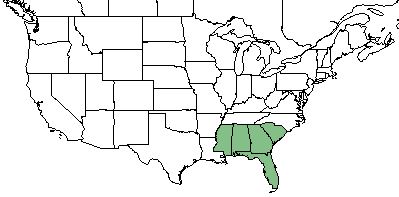Hypericum myrtifolium
Common name: myrtleleaf St. Johnswort; polebark St. Johnswort
| Hypericum myrtifolium | |
|---|---|

| |
| Photo by the Southeastern Flora Plant Database | |
| Scientific classification | |
| Kingdom: | Plantae |
| Division: | Magnoliophyta - Flowering plants |
| Class: | Magnoliopsida - Dicots |
| Order: | Theales |
| Family: | Clusiaceae |
| Genus: | Hypericum |
| Species: | H. myrtifolium |
| Binomial name | |
| Hypericum myrtifolium L | |

| |
| Natural range of Hypericum myrtifolium from USDA NRCS Plants Database. | |
Contents
Taxonomic Notes
Description
H. myrtifolium is a native perennial shrub that is a member of the Clusiaceae family. [1] It is most recognizable by its clasping leaves, which are usually glaucous. [2]
Distribution
H. myrtifolium is a southeastern coastal plain endemic species, found mainly in Florida, but can also be found sparingly in southern Alabama, Gerogia, and Mississippi.[1][3]
Ecology
Habitat
H. myrtifolium is primarily found in habitats surrounding ponds.[3] It is naturally found in fresh-water communities and marshes infrequently. [4] Other natural communities include sandhills and flatwoods. [5] More specifically, H. myrtifolium can be found in dry loamy sand in open pine woodlands, sand pine stands, moist loams of swales in pine woodland, and in shaded swamps.[6] It is listed by the USDA Natural Resources Conservation Service as a facultative wetland species that is most often found in wetland habitats but can also occasionally be found in non-wetland habitats.[1]
Associated species - Hypericum harperi [6]
Phenology
H. myrtifolium commonly flowers from April until June.Cite error: Closing </ref> missing for <ref> tag [6].
Conservation and Management
Cultivation and restoration
Photo Gallery
References and notes
- ↑ 1.0 1.1 1.2 USDA Plants Database URL: https://plants.usda.gov/core/profile?symbol=HYMY
- ↑ Carr, L. G. (1940). "Further notes on coastal floral elements in the bogs of Augusta County, Virginia." Rhodora 42(495): 86-93.
- ↑ 3.0 3.1 Weakley, A. S. (2015). Flora of the Southern and Mid-Atlantic States. Chapel Hill, NC, University of North Carolina Herbarium.
- ↑ Hilmon, J. B. (1964). "Plants of the Caloosa Experimental Range " U.S. Forest Service Research Paper SE-12
- ↑ Platt, W. J., Gregory W. Evans, and Mary M. Davis (1988). "Effects of Fires Season on Flowering of Forbs and Shurbs in Longleaf Pine Forests." Oecologia 76(3): 353-363.
- ↑ 6.0 6.1 6.2 Florida State University Robert K. Godfrey Herbarium database. URL: http://herbarium.bio.fsu.edu. Last accessed: June 2018. Collectors: Loran C. Anderson, Wilson Baker, R. A. Norris, Robert K. Godfrey, R. Komarek, M. Davis, J. M. Kane, Cecil R. Slaughterm and R. Kral. States and counties: Florida: Leon, Wakulla, Duval, and Madison. Georgia: Thomas and Clinch.